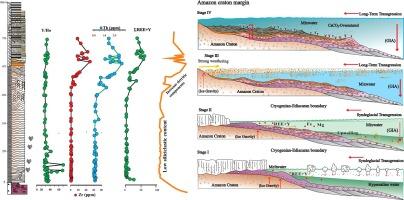稀土元素作为亚马孙克拉通后玛利诺纪(∼635Ma)古海洋学变化的指标
IF 3.2
2区 地球科学
Q2 GEOSCIENCES, MULTIDISCIPLINARY
引用次数: 0
摘要
在新近纪末期,与雪球地球气候相关的大面积冰川退缩引起了海洋化学的剧烈变化,这在全球分布的盖状碳酸盐层中得到了特别的记录。最壮观的例子之一是出露于亚马逊克拉通的普加帽碳酸盐岩(635Ma∼635Ma),它与冰川-等静力调整和当地冰重力相关的广泛海平面变化有关,导致水体持续混合。这项研究采用全面的多代理方法,细致评估了复杂的后马里诺时期动态。普加帽碳酸盐中的稀土元素+钇(REE+Y)模式并不能准确地反映全球海洋水的组成;相反,它们主要是根据后雪球地球事件的局部表现而分馏的,包括碱度水平和马里诺冰川后的淡水混合。扁平化的 REE+Y 模式伴随着正 Eu 异常,这可能暗示了大陆风化作用的影响。具体而言,盖顶白云石中较低的Y/Ho比值与融水流入造成的海水稀释(Y/Ho∼ 29-32)相一致。相反,基底帽状白云岩中的超软岩 Y/Ho 比率高达 71,表明沿岸地区的高盐度海水上涌。受冰重力影响的浅水重现导致沿岸不断隆起,形成孤立的陆架和二迭石变形,形成不规则的基底浮雕形态。冰期过后,随着初级生产力的迅速恢复,海岸线向陆地大幅迁移,大型微生物群落蓬勃发展,在白云石平台上受限的古环境条件下,白云石沉淀形成。海平面的迅速上升导致蒸发流体稀释,最终停止了白云岩的沉淀。在前冰期跃迁之后,分层水体逐渐变得更加混杂,导致白云质平台沉积终止,与此同时,不溶性元素(如 REE、Zr 和 Th)的增加表明了碎屑成分的增加,随后在后冰期跃迁期间,碎屑成分突然被 CaCO3 过饱和海所取代。这些观测结果阐明了冰期后-始新世边界期间冰期后与古海洋动力学之间的相互作用。本文章由计算机程序翻译,如有差异,请以英文原文为准。

Rare earth elements as indicators of post-Marinoan (∼635 Ma) paleoceanographic changes from the Amazon Craton
The extensive deglaciation linked to the Snowball Earth climate that elapsed in the terminal Neoproterozoic caused dramatic changes in ocean chemistry, exceptionally recorded in globally distributed cap carbonate successions. One of the most spectacular examples is the Puga cap carbonate (∼635 Ma), which is exposed in the Amazon Craton and associated with extensive sea level changes related to glacial-isostatic adjustment and local ice gravity, resulting in continuously mixed waters. This study meticulously evaluates complex post-Marinoan dynamics using a comprehensive multiproxy approach. The rare earth element + yttrium (REE+Y) patterns in the Puga cap carbonate do not accurately reflect the global ocean water composition; instead, they primarily fractionate in response to local expression of the post-Snowball Earth event, including alkalinity levels and freshwater mixing in the aftermath of the Marinoan glaciation. The flattened REE+Y pattern, accompanied by a positive Eu anomaly, may suggest the influence of continental weathering. Specifically, low Y/Ho ratios in the cap dolostone are consistent with seawater dilution due to meltwater influx (Y/Ho ∼ 29–32). Conversely, superchondritic Y/Ho ratios up to 71 in the basal cap dolostones suggest upwelling of hypersaline seawater in coastal areas. The shallow-water recurrence influenced by ice gravity resulted in continuous coastal uplift, forming isolated shelves and the deformation in diamicton, resulting in irregular substrate relief morphologies. This post-glaciation scenario was succeeded by significant landward shoreline migration concomitant with rapid recovery of primary productivity, with large microbial communities flourishing, inducing dolomite precipitation under restricted paleoenvironmental conditions on dolomitic platforms. The rapid rise in sea level led to the dilution of evaporative fluids, ultimately halting dolomicrite precipitation. Following the pos-tglacial transgression, the stratified waters gradually became more mixed, resulting in the termination of dolomitic platform deposition and coinciding with an increase in detrital components, as indicated by the increase of insoluble elements (e.g., REE, Zr, and Th), followed by abrupt replacement by CaCO3-oversaturated seas during the post-glacial transgression. These observations elucidate the interplay between post-glaciation and paleoceanographic dynamics during the Cryogenian-Ediacaran boundary.
求助全文
通过发布文献求助,成功后即可免费获取论文全文。
去求助
来源期刊

Precambrian Research
地学-地球科学综合
CiteScore
7.20
自引率
28.90%
发文量
325
审稿时长
12 months
期刊介绍:
Precambrian Research publishes studies on all aspects of the early stages of the composition, structure and evolution of the Earth and its planetary neighbours. With a focus on process-oriented and comparative studies, it covers, but is not restricted to, subjects such as:
(1) Chemical, biological, biochemical and cosmochemical evolution; the origin of life; the evolution of the oceans and atmosphere; the early fossil record; palaeobiology;
(2) Geochronology and isotope and elemental geochemistry;
(3) Precambrian mineral deposits;
(4) Geophysical aspects of the early Earth and Precambrian terrains;
(5) Nature, formation and evolution of the Precambrian lithosphere and mantle including magmatic, depositional, metamorphic and tectonic processes.
In addition, the editors particularly welcome integrated process-oriented studies that involve a combination of the above fields and comparative studies that demonstrate the effect of Precambrian evolution on Phanerozoic earth system processes.
Regional and localised studies of Precambrian phenomena are considered appropriate only when the detail and quality allow illustration of a wider process, or when significant gaps in basic knowledge of a particular area can be filled.
 求助内容:
求助内容: 应助结果提醒方式:
应助结果提醒方式:


